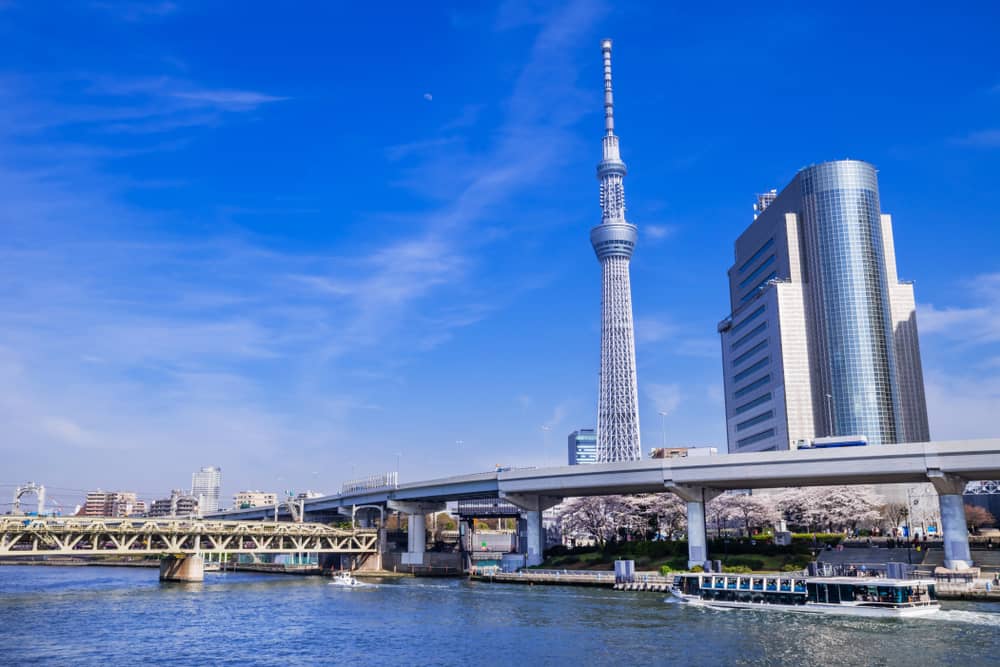Asakusa Station sits on the banks of the Sumida River in Tokyo’s Taito special ward. Built in 1927, it’s a tall, imposing building with a clock tower.
It really looks as though it has been transplanted from historic Paris or London, and is spectacularly illuminated at night. It also serves as a gateway to some of the city’s most cherished cultural landmarks.
If you’re in the area to explore local attractions, Asakusa Station provides a convenient and memorable starting point. Read on to find out how to navigate the station and enjoy the vibrant area around it.
Table of Contents
Getting to Asakusa Station
Asakusa is accessible via several transportation options including the Tsukuba Express, Tobu Railway, and the Tokyo Water Bus.
You can also reach the station via multiple subway lines, ensuring a straightforward journey regardless of your starting point in Tokyo.
From Tokyo Station
From Tokyo Station, take the JR Yamanote Line to Kanda Station, which takes about 2 minutes. This journey is included in your JR pass.
Then, transfer to the Ginza Subway Line to reach Asakusa. This journey takes approximately 10 minutes and costs 180 yen.
From Shinjuku Station
Board the orange JR Chuo Line to Kanda Station, a 10-minute trip covered by your JR Pass.
Once there, switch to the Ginza Subway Line to continue to Asakusa, which also takes about 10 minutes. It will cost you an additional 180 yen.
Asakusa Station train lines
Asakusa Station is serviced by multiple operators, including:
- Tobu Railway: the Skytree Line, along with Limited Express trains like the Spacia Kegon and Ryomo, depart from here
- Tokyo Metro: services the Ginza Line
- Toei Subway: serves the Asakusa Line and provides direct access to both Haneda and Narita Airport through its two platforms
- Tsukuba Express: mainly used by locals commuting to and from the Ibaraki and Tsukuba regions
There is also a bus stop outside most of the stations.
As a non-JR station, Asakusa does not serve any JR trains. As such, these lines are not covered by the Japan Rail Pass, so you will need to pay additional fees to ride these trains.
Asakusa Station layout
The station complex actually consists of 4 different stations.
The Tobu Railway station shares the space of the Matsuya Department Store. It has 3 island platforms serving five tracks. Tracks 1 and 2 serve local, semi-express, and express trains.
Tracks three and four provide access to the various Limited Express trains. Track five serves the Limited Express Revaty.
The two side platforms of the Tokyo Metro station are located underground. Look for green-roofed structures of traditional architecture covering the stairwells.
To the south of the Tokyo Metro station is the underground Toei station. It has 2 platforms serving the Toei Asakusa Line. You can reach Haneda Airport from Platform 1, and you can get to Narita Airport via Platform 2.
Connecting passages link Tobu station to the Tokyo Metro station and the Tokyo Metro station to the Toei station. However, there is not a direct passage between the Toei and Tobu stations.
The Tsukuba Express is located in an additional station portion, 600 meters to the west of the primary station complex. This portion of the station has a single underground island platform on the fourth basement level.
Locker services at Asakusa Station
Each of the station portions provides both key and automatic storage lockers. You can use IC cards such as Pasmo and Suica to access the automatic lockers. They come in 3 different sizes.
There are relatively few lockers compared to the number of passengers, and they sometimes may all be full. If so, you can use the Yamato Transport Service Counter in the Ekimise Department Store, in the same building as the Tobu station.
Things to do near Asakusa Station

There is plenty to do in Asakusa Station’s surrounding area, whether you are interested in history, shopping, or dining.
You’ll find a large variety of restaurants and theaters right outside the station. And if you feel like a shopping spree, you have the Ekimise Department Store right in the Tobu Station building. Another option is the Rox Department Store to the southeast.
One of the most notable attractions in the vicinity is Senso-Ji Temple, located 300 meters west of the Tsukuba Express portion of the station.
Senso-Ji is the oldest and most significant Buddhist temple in Tokyo, and is often considered one of the best temples in Japan. It’s also the most visited spiritual site in the world, as over 30 million travelers make a pilgrimage there each year.
If you’re visiting the area as a family, then a trip to the nearby Hanayashiki Park is a must. Originally opened as a flower park in 1853, Hanayashiki has evolved into a charming venue that offers a nostalgic experience with its vintage-style rides and attractions.
Now officially the oldest amusement park in Japan, the space entices visitors with rollercoasters and carnival rides, the iconic Panda Car, a Kid Ninja Park, and gaming plazas.
